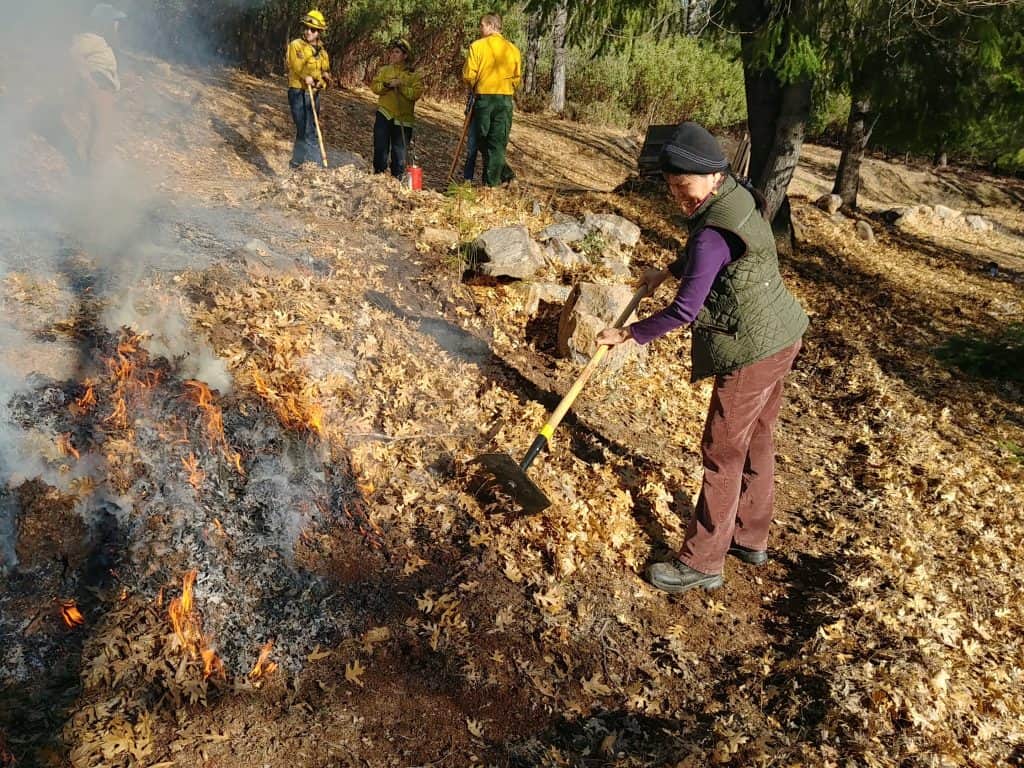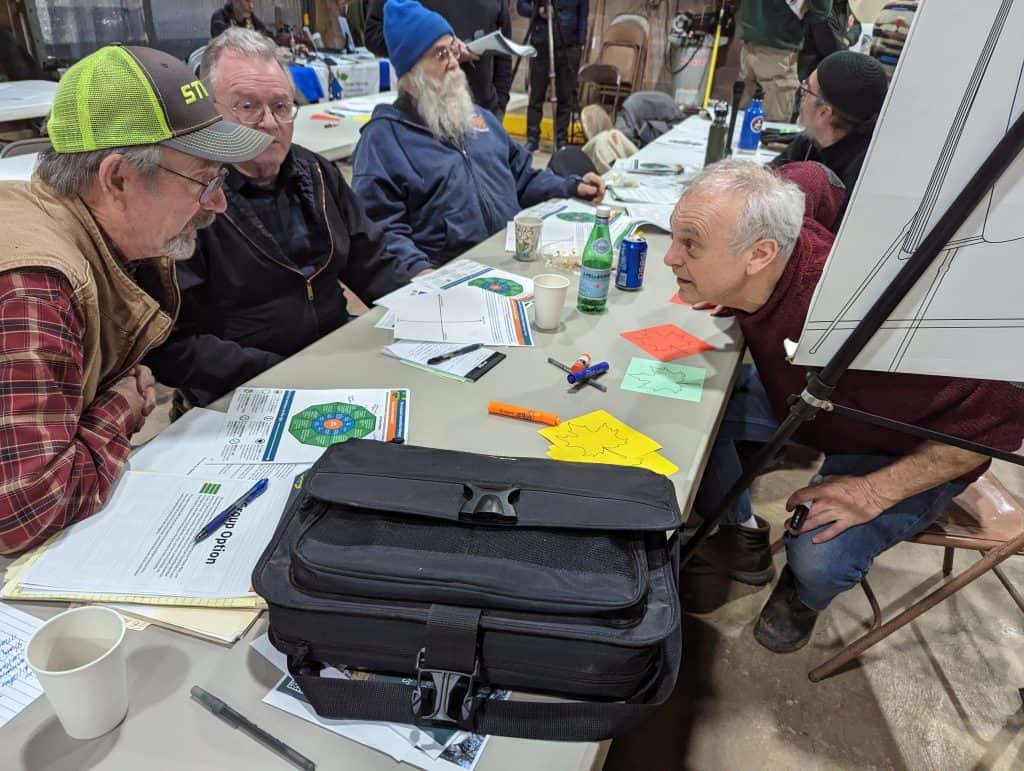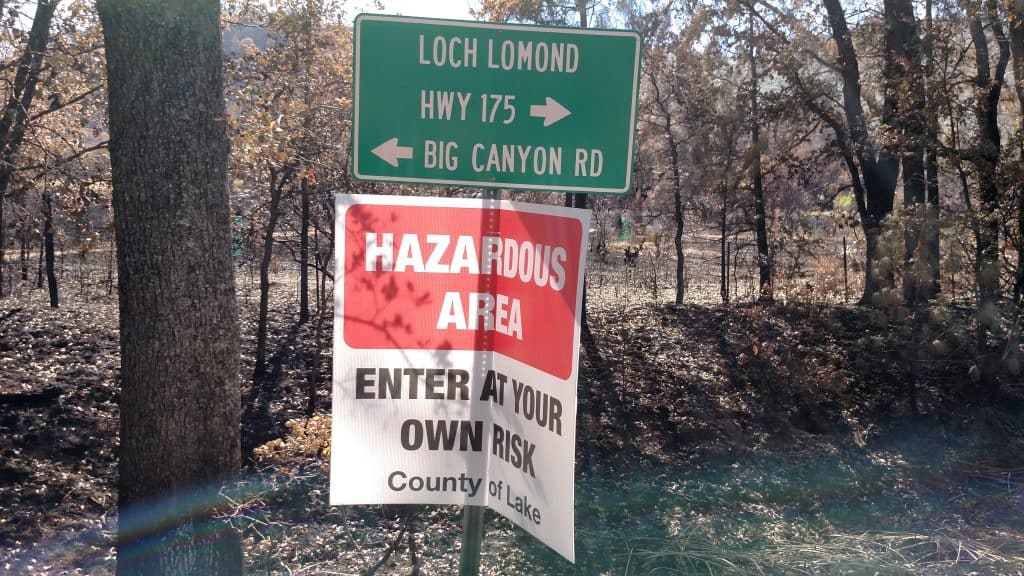Editor’s note: In this blog, we sit down with longtime FAC Net member Magdalena Valderrama to discuss how her community and her fire adaptation work have changed in the decade since the 2015 Valley Fire in Lake County, California. Magdalena lost her home in the Valley Fire and subsequently co-founded the nonprofit Seigler Springs Community Redevelopment Association (SSCRA). Magdalena’s work has been featured on the Fire Networks blog over the years – read our conversation with her from November 2020 for references to how her work has evolved over time. Blog cover photo: Sulphur Creek from Wilbur Springs in Lake County, CA, Getty Images. All other photos provided by the author.
Fire Networks: Tell us a little about where you are currently in your journey of fire adaptation work. How did you get to where you are now?
Magdalena: As a wildfire survivor, I wanted us to do better than wait for the next fire. A third of our county’s population was displaced because of this particular fire alone. And as we slowly developed the capacity with our community to act on our own terms of recovery, I quickly found myself in a forest of fire-related organizations and acronyms! Making sense of which ones I actually needed took the better part of three years while my husband and I handled insurance paperwork, replenished our living situation, and pivoted around building a fire-wise housing cooperative. Meanwhile, participation in FAC Net really gave me the confidence to track down our county’s Community Wildfire Protection Plan and press persistently to get it updated. I’m really grateful for the doors that FAC Net opened for me in terms of the information and training you all made available. And then there were the resources, whether it was a COCO AIM grant supporting us in conducting home risk assessments and training a group of volunteers to do the same, or a a course with the Indigenous People’s Burning Network that forever changed how I understand our landscape and its people and how to realign with fire-adapted culture and healthy fire dependence.
When I’m not conducting evacuation and fire mitigation webinars/seminars for various neighborhoods, as I did last year, I continue to participate in prescribed or cultural burns where or when I can. I exercise my role as one of two Firewise Communities Community Regional Coordinators in the county, keeping the conversations going, pointing to or organizing everyone to take advantage of whatever fire mitigation resources might be available, adding my own mitigation practice reminders to neighbors and fellow leaders for the Firewise Community I live in. Earlier this year, our nonprofit team organized and hosted a Cobb-based forest summit in preparation for the CWPP process that we can now re-engage.

As I write, we’ve only just been given the go-ahead on a federal grant originally awarded late last year to develop a hyperlocal CWPP that will be tied in with the county’s. And we have reason to hope that the state’s budget adjustments following the federal funding re-alignment can also permit forward movement on Phase II of our Cobb Watershed Education and Restoration Program (Cobb WERP) in partnership with the Big Valley Band of Pomo Indians. It’s very important to us as an organization to promote and support Indigenous stewardship in collaboration with the current, private landowners.
On a personal note, despite having grown up in big cities like metro-DC and New York, I’m now quite comfortable with driving a half-ton pickup truck in rural mountain subdivisions!
How has your community changed since the 2015 Valley Fire? What strengths and/or challenges were revealed by going through the experience?
I have to answer that on two levels, one at the county level and the other at the hyperlocal level. Usually, when government agencies call for local input or consideration of a topic, the smallest scale they reach for is at the county level. For a small county like ours, where the entire county population matches the population of a nearby city in an adjacent county, it’s no small matter to have the attention of the state and federal governments. However, our section of the county encompasses many of what could be called hamlets, i..e. population centers lacking any centralized economy or significant administrative functions, nestled all around and along mountain roads and terrain. Improvements for wildfire adaptation in our mountain area could not move far forward without interacting with county-level awareness and attention, just as the county could not advocate effectively to the state without knowing the concerns at the comparatively hyperlocal level.
As we now know is typical of rural counties challenged in their ability to live well with wildfire, I quickly discovered that there had been group meetings of various kinds, but there did not seem to be any existing collective capacity to determine what, where, when, why, and how the various government and nonprofit agencies might need to prioritize wildfire adaptation efforts on any sort of scale. The meetings our team attended seemed mostly informative, without much knowledge about how to take advantage of partnerships. In fact, it wasn’t even clear whose responsibility it was to monitor, track, and update what turned out to be a very robust county CWPP, much less how to go about performing the required tending. And while there was some professed interest in seeking outside assistance through grants, there seemed little imagination about where to start, much less any appetite for writing the necessary applications and tracking outcomes.
All this has changed as members of the greater community continue to raise important questions and participate in resolving the questions. Local government is often the recognized convener in places like ours, where the meetings and discussions could take place that were so needed to examine, prioritize and implement any of the solutions on offer. At key points in the discussions, outside facilitators experienced in tying together the myriad aspects of wildfire adaptation mitigation were invited in to share best practices and help delineate paths forward.

We have changed our own grant climate over these past years. For example, the countywide fire safe council has been entrusted with tracking grant opportunities, lead agencies, and partnerships among the local entities addressing fire-related issues. We share opportunities and are able to partner more easily with each other. Since the CWPP is in place, the priorities are clear and we can cheer each other on for good projects, knowing that it’s all about bringing in much-needed resources for at least one place in the county if not for multiple locations. More county residents have become aware of what is at stake and try to get onto the priority project lists commanded by the incorporated organizations.
Many articles have been written about how repeated disasters occurring in short order interfere with adaptation work, including a recent FAC Net blog by Tiernan Doyle and Climigration Network Staff. The many challenges along the way have been exhausting to get beyond simple willingness or ambition to change things for the better. And this has certainly been the case in Lake County!
Still, the combination of all these developments means to me that critical recognition and acknowledgment of our deeper interdependence with one another in these wildfire-prone landscapes and times is starting to unfold at a more perceptible level for ordinary residents. I also trust that it will continue to happen despite the recent policy changes at the federal level earlier this year which has thrown the wildfire mitigation planning environment into its present disarray.
What are three significant events over the past decade since the Valley Fire that have shaped your community’s relationship to fire?
- I can’t say enough for the CWPP process. Raising community awareness of the Community Wildfire Protection Plan (CWPP) has been crucial, as its recent update has reignited the focus on wildfire preparedness and more clearly defined the role of the Resource Conservation District in the plan’s effectiveness. Meanwhile, the County General Area Plan is currently in the process of being updated, and understanding how these two plans relate to one another is vital for comprehensive community resilience.
- Establishing collaboration between the County and the Mendocino National Forest to request a Community Mitigation Assistance Team (CMAT) helped us consolidate all the previously identified disparate elements, organizations, and priorities into one priority map. This map will guide our collaboration as participating organizations implement various projects, even in the absence of a formal implementation plan for the Community Wildfire Protection Plan.
- The inclusion of tribal representatives in a new joint powers authority for risk reduction, covering all natural hazards. California mandates that each of its counties establish a disaster council, but there hasn’t been any specific guidance regarding sovereign tribes in the local region. Our county has seven sovereign tribes, each of which commands much less than a couple of percentage points of the land they once lived on.
What do you notice when you speak with your community members today about the Valley Fire? How have their (or your) perspectives stayed the same, or become different?
The perspectives continue to run the gamut of fear/PTSD/complacency all the way to enthusiasm for cultural burning. Very early this year, I got a phone call from a neighbor of 25+ years who asked me to never include the word “fire” in the subject line of my email reminders about evacuation readiness or wildfire prevention because it was too traumatizing. Then at a local garage sale this past summer, I met a man who bought a second home only seven years ago in a nearby neighborhood and who took obvious pride in all the work he has performed to create and maintain defensible space. Yet another person I spoke with about a completely different topic stopped to thank me for my notices because, she said, she had become complacent. The concept of co-stewardship of public lands with tribal governments is openly discussed at the same time that debate continues in the wider community about recognition of tribal sovereignty. These random encounters underscore the continuing need to develop community cohesion, a major factor that emergency and mitigation experts recognize as critical to wildfire safety.

What have been some challenges to the recovery process? How would you advise communities going through long-term wildfire recovery?
Last week, during a planning meeting for the commemoration of the 10th anniversary of the Valley Fire, it was determined that now is not the time to bring up just how many homes have been rebuilt because of the complexities involved in measuring and tracking the progress. Repeating the litany of complexities would take another article and probably a book by itself, and best told by an expert in these matters. But my advice remains the same as in my original interview with FAC Net – with one additional summary statement: Resilience and well-being are not anything anyone can give you, they are the actions you take every day to affirm the fundamental wholeness of your being. As soon as you can, become part of the tide that can help lift all boats, meaning get involved in setting and advocating for your community’s recovery priorities – doing so will speed your own recovery from the disaster because then you are participating in and helping shore up an environment that can support many people at once.
In another five years from now, what do you hope to see in terms of your community’s relationship to fire?
I like to tell the people in my immediate neighborhood that as we continue to cooperate with one another in living well with wildfire, soon we will be able to do as our Indigenous brothers and sisters have done and still do as they can, to reclaim fire as an efficient and humble servant for cleaning up the land and one day soon do a neighborhood burn together. They look at me incredulously now, but we’ll see.
****
